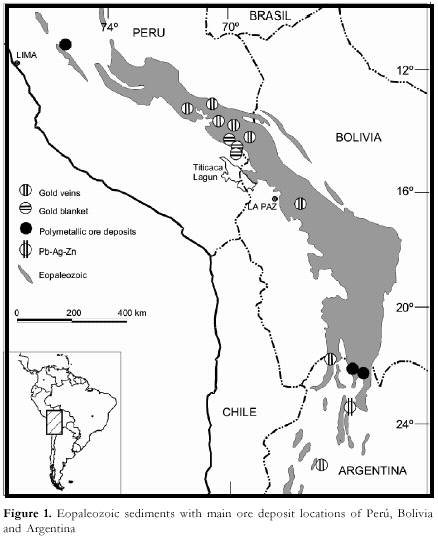
Ordovician
Mineralizations in Argentina
Isidoro
B. SCHALAMUK1-2 and de R.E. de BARRIO1
1 Instituto de Recursos Minerales (UNLP-CIC), calle 47 N° 522 (1900) La Plata, E-mail: inremi@infovia.com.ar
2 Consejo Nacional de Investigaciones Científicas y Técnicas
Abstract:
ORDOVICIAN MINERALIZATIONS IN ARGENTINA.
The regional geological knowledge of the Lower
Paleozoic of South America has developed especially in the last years important
advances in the characterization of the great geotectonic lineaments. The
development of extensive sedimentary basins affected by important tectomagmatic
events has favored and controlled the generation of extensive mineralized belts
in terranes of Lower paleozoic age.The Ordovician sequences that extend from the
south center of Peru, Bolivia up to the north of Argentina, are the most
important from the metallogenic point of view. They register mineralizations
that cover a wide areal distribution and in some cases they constitute very
important ore deposits. In Argentina, the Ordovician sedimentites are emplaced
in different regions, comprising especially in some cases, areas with
exceptional mining potential in Sedex type deposits (Aguilar-Esperanza) and
volcanogenic potential in Kuroko type deposits, associated with an Ordovician
volcanic arch. In the northwest region they comprise the provinces of Jujuy,
Salta, Catamarca and La Rioja, and in the last one, it is found the Famatina
basin which also shows favorable conditions to host sedex and VMS type deposits.
On the other hand, in the Precordillera region of La Rioja, San Juan and Mendoza
provinces, deposits associated with the Ordovician are found. They have an
enormous development of limestones, dolomites and pelitic rocks with stratabound
barite deposits and possible sedex, polymetallic and massive sulphides deposits.
Its potential is not very well-known yet. Finally, in Buenos Aires provinces,
and associated with the Ordovician sequence of the Tandilia System, clay
deposits have been exploited for several decades.
Resumen:
MINERALIZACIONES
ORDOVÍCICAS EN ARGENTINA.
El conocimiento
geológico regional del Paleozoico Inferior de América del Sur ha operado en
los últimos años importantes avances especialmente en la caracterización de
los grandes lineamientos geotectónicos. El desarrollo de extensas cuencas
sedimentarias afectadas por importantes eventos tectomagmáticos ha favorecido y
controlado la generación de extensas fajas mineralizadas en terrenos de edad
paleozoica inferior. Las secuencias ordovícicas, que se extienden desde el
centro sur de Perú, Bolivia hasta el norte de Argentina, son las que alcanzan
mayor importancia metalogénica. Registran mineralizaciones que cubren una
amplia distribución areal y en algunos casos constituyen yacimientos de gran
significación económica. En Argentina, las sedimentitas ordovícicas se
emplazan en diferentes regiones, conformando en algunos casos áreas con
excepcional potencial minero en especial en depósitos tipo SEDEX
(Aguilar-Esperanza) y potenciales depósitos volcanogénicos tipo Kuroko,
vinculados a un arco volcánico ordovícico. En el noroeste comprenden las
provincias de Jujuy, Salta, Catamarca y La Rioja, encontrándose en esta última
la denominada cuenca del Famatina, que también muestra condiciones favorables
para albergar yacimientos tipo sedex y VMS. Por su parte, en la región
precordillerana de La Rioja, San Juan y Mendoza, es de destacar la presencia de
depósitos ligados al Ordovícico, con un enorme desarrollo de calizas, dolomías
y rocas pelíticas con depósitos estratiformes de baritina y posibles sedex,
polimetálicos y sulfuros masivos cuyo potencial aún no es bien conocido.
Finalmente, en ámbito de la provincia de Buenos Aires y vinculados a la
secuencia ordovícica del Sistema de Tandilia, existen depósitos de arcillas
que se explotan desde hace varias décadas.
Key
words: Mineralizations. Ordovician. Argentina
Palabras
clave: Mineralizaciones. Ordovícico.
Argentina
Introduction
The
regional geological outline of the Lower Paleozoic of South America has widely
developed with regard to the knowledge of its large geotectonic features, in the
last years. The high degree of regional metamorphism of some paleozoic units
located in the tectonically active areas, especially in the western sectors, has
hindered its differentiation regarding the lands of upper Precambrian that crop
out rarely and fragmentally along the whole Andean belt. On the other hand, in
the most stable ones, the paleozoic rocks show a weak metamorphism that has
practically not obliterated the original sedimentary and paleontological
features and this has allowed a better characterization of the stratigraphy and
of the paleoenvironmental conditions as well.
From the evolutionary point of view, in South America the tectomagmatic events and the properly sedimentary ones favored and controlled the mineralization settings with the formation of big mineralised belts in units of the Lower Paleozoic (Fig. 1). The ordovician sequences are those that reach greater metalogenic importance in the central Andes and the Precordillera area, since they register mineralizations that cover a wide areal distribution and, in some cases, they constitute very important ore deposits from the economic point of view. The Ordovician sedimentites that occur from the south center of Peru and Bolivia up to the north of Argentina, contain an exhalative submarine volcanism that constitutes the main source of Pb-Zn-Cu-Ag and Ba concentrations of South America. In our country they are emplaced in two well differentiated basins, one in the

northwestern
area (Fig. 2) and another one defined as the Famatina basin. A third area, with
deposits associated with the Ordovician, is emplaced in the precordillera area
of La Rioja, San Juan and Mendoza provinces.
The great extension of the Ordovician basin in the northwest of Argentina, with well defined stratabound and world class deposits (El Aguilar mine) and numerous Au and sulphides occurrences (Fig. 3), associated with the sedimentary sequence, forms an area with an exceptional mining potential especially in SEDEX and VMS type deposits. Metallogenic aspects in the region were considered, among others, by Coira et al., (1982), Angelelli (1984), Zappettini (1990), Schalamuk et al. (1992); Pérez et al. (1998), Sureda (1999), Méndez et al. (2001), Peralta et al., (2001) and Lencina and Peralta (2002) who emphasize the potential of mining resources that characterizes the area.
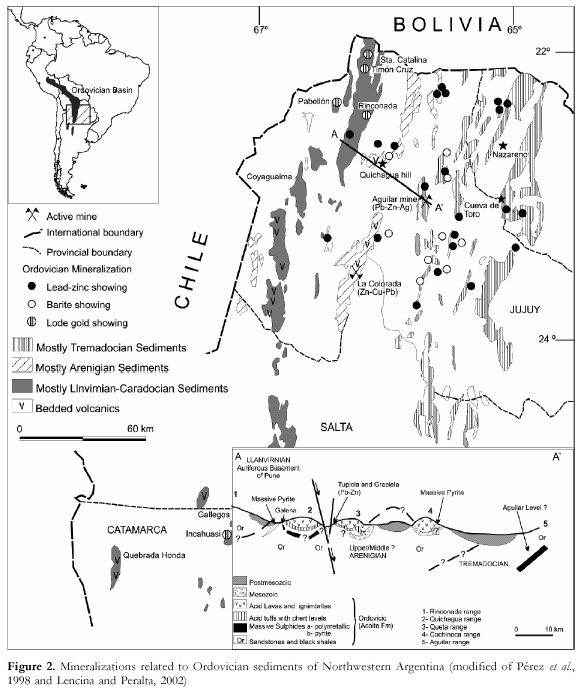
The
submarine volcanism, simultaneous with the ordovician sedimentites, favored the
process of concentration of large accumulations of Pb-Zn-Cu and Ba of the South
America Paleozoic that extends like a belt, from the northwest of Argentina
(with the SEDEX type Aguilar-Esperanza, La Colorada-Limeca deposits) up to Cerro
Pasco latitude, in Peru.
Northwestern
region
El
Aguilar-Esperanza District:
Without
any doubt this Pb-Zn an Ag district is the most important in its type in
Argentina as well as in all South America. It is located in Jujuy province, in a
transition environment between the Puna and the Cordillera Oriental. The
district comprises two important mines, El Aguilar and La Esperanza, being the
first one the most significant producing center, because of the volume yielded
since 1936, registering during decades a sustained daily production of 2.000 to
2.200 t. of ore with grades of 8,4% in Zn; 5,55 in Pb and 90 to 120 g/t Ag. Even
nowadays it is in full operation and with a good reserve level.
El Aguilar ore deposit shows a syngenetic mineralization with the Ordovician sedimentation. (Padrioc and Lampazar Formations), Fig. 4. It is a stratified deposit associated with orthoquartzites. Essentially the ore minerals are: iron bearing sphalerite; galena, pyrite and as minor components, pyrrhotite, tetrahedrite-tennantite, pyrargirite, arsenopyrite and molybdenite (Sureda, 1999). The
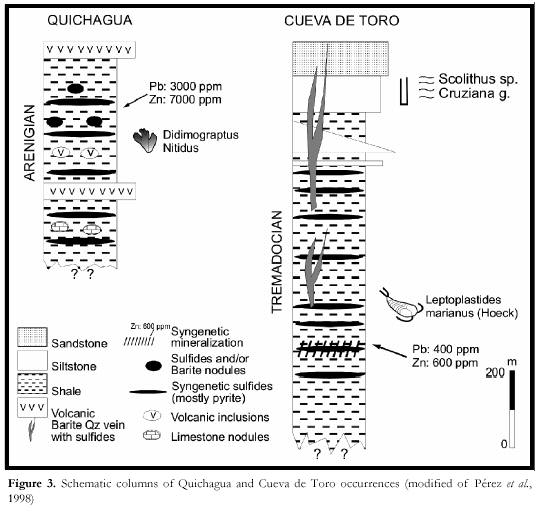
great
volumes of existent ore are due to geothermal sources, partly exhalative, that
caused the flow of thick metal-bearing brines in the sea floor of the lower
Tremadocian. (Sureda 1999).
Esperanza
mine (Pb-Zn-Ag) is emplaced in oceanic siliciclastic sediments (Lampazar
Formation) deposited in the Upper Cambrian-Tremadocian. The mineralogy consists
of pyrite, galena, iron bearing sphalerite and pyrrhotite, and in lesser
proportion silver sulphosalts, marcasite and baryte gangue.
La
Colorada-Limeca District.
It
is partially explored and it also shows characteristics similar to the
sedimentary-exhalative pattern. It is considered that the mineralization took
place from hydrothermals fluids exhaled in the sea floor and then channeled by
pipes controlled by faulting (Lurgo Mayón et al., 1999). The district is
located in Sierra de los Cobres, the Puna Oriental first step, in Salta
province.
La
Colorada mine shows stratified bodies and levels of massive or semimassive
sulphides with thickness of 2,5 to 10,8 m and grades of up to 10% of Zn, 7% of
Pb, 2,11% of Cu and 13 g/t of Ag and some levels with values of up to 0,7g/t of
Au. (Lurgo Mayón et
al., 1999). The wall rocks of the ore deposit comprise
meta-pelites, with metaquartzite intercalations and metadolomites that are
assigned to the Chiqueros Formation (Lower Ordovician). The group is affected by
metasomatism due to the intrusion of the Granodiorite Cobres that produced the
development of skarn rocks.
The
mineralization is emplaced in the eastern slope of a great antiform and the
granodiorite Cobres is located in its nucleus. The main mineralization consists
of sphalerite, pyrrhotite, arsenopyrite, chalcopyrite, and minor lollingite,
magnetite and cassiterite.
Limeca is a very interesting prospect; its sulphide outcrops occur interbedded with the ordovician
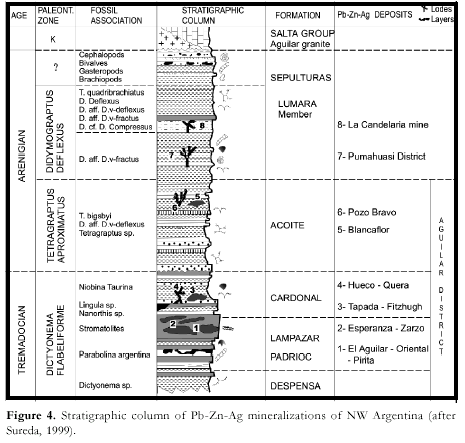
sedimentites,
affected by a low metamorphism. The recognized mineralogy belongs to pyrite,
esfalerita, graphite sheets and chalcopyrite (Méndez and Méndez, 2001; Méndez
et al., 2001).
In
the central area of the Calalaste range, Southern Puna, in Catamarca province, a
mineralization of Fe, Zn and Cu rich sulphides is found in a complex environment
of pelites, quartzites, wackes, lavas, tuffs and ignimbrites, of an Ordovician
age. The group shows a structural configuration that belongs to a folded and
thrusted belt. The sulphide bodies are synsedimentary associated with the
dacitic volcanism and with pelites deposits in restricted environments (Méndez et
al., 2001).
In
the same central area of the range, basic and ultrabasic rocks are found,
consisting of cumular gabbros, gabbros and basalts that constitute a
volcaniclastic intrarc sequence. Hongn et al. (1999), recognize strong
metallic anomalies and they state a model of sinextensional basin and the
occurrence of a potential massive deposit of submarine volcanogenic type or
Kuroko type.
Pumahuasi
Polymetallic District
The
district is located in the Cordillera Oriental environment, Yavi department, in
Jujuy province.
They
occur in Pb, Zn, and Ag bearing vein structures hosted in shales and interbedded
sandstone of the Acoite Formation, affected by low metamorphism. The district
that was exploited in the first decades of the last century, is included as part
of a belt that extends up to about 500 kms to the north, penetrating in Bolivia.
In
a zone of 15 km strike north-south and approximately 3 km wide, three systems of
veins are recognized, with thickness that oscillate between 20 and 40 cm and
lengths of some hundreds meters. The main system shows a strike N55º-80ºW; a
second one strike N40º-65ºE and a third one formed by a single vein strike N 5º
E. They occur as fault fillings, showing a strong vertical zoning, with high Pb
concentrations in its upper portion and Zn in the lower levels.
The mineralization consists of galena, sphalerite, chalcopyrite, pyrite, arsenopyrite, silver sulphosalts and supergenic copper sulphides. The gangue minerals consist mainly of quartz, barite and siderite. The mineralogy and its structural and isotopic characteristics and the setting environment, allow to classify them as veins in sedimentary clastic terranes according to Beaudoin and Sangster,
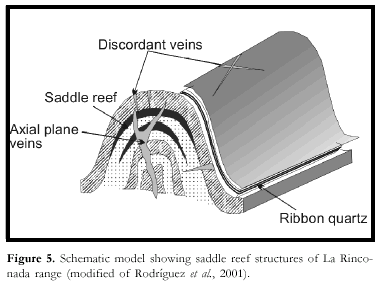
1992
(in Segal et al., 1999), where the cortical faults and deformational and
metamorphic events constitute an important role in their genesis.
La
Rinconada District
This
important district of auriferous veins is emplaced in the area called Sierra La
Rinconada, in the Puna environment and it extends from the limit of Bolivia up
to the 23º00’ parallel of south latitude, in Argentina. The numerous
mineralized structures were focus of sporadic exploitation and they constitute
Azules, El Torno, Santo Domingo, Farillón, Pabellón, El Carmen mines, among
others. In general, lengths of few meters up to some hundreds of meters and
thickness from centimeters to several decimeters, are observed. The gold grades
are intermediate, although contents of up to 120 g/t and even higher are shown.
They
are generally located, in a sedimentary turbiditic sequence made up of
ordovician marine leptometamorphic deposits belonging to the Acoite Formation
(Zappettini and Segal, 1999), locally covered by continental sediments and
volcanic and porphyric rocks of tertiary age. The district is characterized by a
group of anticlines and synclines with inclinations to the north, originated by
ocloyic movements. The sequence was affected by a faulting associated with the
Andean tectonic that gave origin to the range. There are several authors who
refer to the different primary gold mineralized structures that were synthesized
by Angelelli (1984) and more recently, among others, Sureda et al., 1986;
Zappettini and Segal 1999 and Rodríguez et al., 2001. In general, the
mineralized veins are located in the anticline axis, in both flanks and parallel
to the sedimentary sequences constituting saddle reef type structures (Fig. 5).
There are also discordant veins next to lens parallel to the ordovician
deposits. The mineralization consists of gold and electrum, abundant
arsenopyrite and pyrite, and in lesser proportion sphalerite, galena,
chalcopyrite, among other subordinated minerals. It is defined an initial
paragenetic sequence with accumulation of gold, arsenopyrite, pyrite and quartz
gangue, ankerite, calcite and graphite, a second stage of gold, sulphides and
sulphosalts and a final stage with native gold and quartz gangue and carbonates.
The
origin of these primary auriferous deposits is presently associated with lateral
exudation or secretion process in an advanced diagenetic stage during the
Ordovician (Sureda et al., 1986). As regard the primary gold source, it
is usually attributed to the exhalative volcanic activity (Coira and Koukharsky,
1994) that occurs, at regional scale, as domes and lavic intercalations, in the
west of La Rinconada area.
Incahuasi
District
In
the Incahuasi Sierra, Southern Puna, in the province of Catamarca, it is located
an auriferous ore deposit with veins that was exploited by the indian natives
(Incas) and Jesuits and, in an active form, between 1936 and 1954. It is
considered a total production lower than 2.000 kg of gold, starting from high
grade auriferous ore, higher than 20 g/t.
The
ore deposit is of the banded type, with quartz veins and veinlets with gold and
minor pyrite, arsenopyrite and chalcopyrite. The mineralized structures are
emplaced in a pelitic and grauwackic sequence of Falda Ciénaga Formation. The
sequence suffered alterations in its composition and texture, due to metamorphic
diagenetic and hydrothermal processes. The area is affected by faults and
fractures in two preferential systems: a north-south one and another one NE-SW
(González, 1999). The deposit is associated with the N-S faulting that would
have affected the Ordovician sequence during the Ocloyic Phase (Navarro Garcia
and Rosello, 1989). The gold bearing quartz veins show lengths of some hundreds
meters and thickness of few centimeters up to three meters. In general plunging
to the east, with values higher than 45º.
It
is considered that the gold source is related to the ordovician magmatism (González,
1999). It is considered that the regional metamorphism and the tectonic
deformation facilitated the generation and migration of hydrothermal fluids
bearing gold that gave as a result the formation of the deposits during the
Upper Ordovician.
Barite
Districts of Santa Victoria and Zenta ranges
In
the Cordillera Oriental, barite deposits are located in Santa Victoria and Zenta
ranges, in the Salta province. These deposits present bedded or in vein
formations hosted in the ordovician sedimentary sequence. They consist of barite
of high purity concentrations or they accompany lead, zinc, copper sulphides and
occasionally native gold and silver.
The
Santa Victoria District that comprises the eastern sector of the homonymous
hill, presents barite concentrations as bodies with veins, in shales and shaly
sandstones from the Ordovician.
There
are several registered deposits, however the most important, for the exploited
volume and for the existing reserves, belongs to the mine known as Mono Abra.
The area shows intense deformation with overturned, fractured and thrust folds.
The mineralization fills faults of the sedimentary sequence. Several veins, of
different thickness (0,45 to 10 m) and up to 800 m of length are found, with
strikes E-W and NE-SW (Schalamuk et al., 1983).
La
Ciénaga mine, according to Méndez et al., (2001) consists of
semiconcordant lenses or beds rich in sulphides. The mentioned authors consider
that the sulphides horizons were deposited in the sedimentary sequence and they
attribute to synsedimentary faults used as feeding channels favoring the
solution circulation and then galena, sphalerite, pyrite precipitation, with
moderate barite occurrence. This characterization constitutes a good indication
for the exploration of new bedded bearing sulphide deposits in Santa Victoria
district.
In
the Sierra of Zenta, in the south of Santa Victoria, another barite district is
located. There are several deposits that mainly register textures with veins,
they are emplaced in Tremadocian shales and sandstones of the Santa Rosita
Formation (Castillo et al., 1996). They show variable lengths of up to
some hundreds of meters and from few decimeters to three meters of thickness.
Aluminous
belt
An
extensive metamorphic aluminous belt extends from the Salar de Pastos Grandes,
Salta, going toward the south of Catamarca province. The outcrops are not
continuous, but they show a good degree of association with the crystallophilic
complex of the Oire Formation (Schalamuk et al., 1983).
The
aluminous deposits consist of fibrous-prismatic aggregates of andalusite,
sillimanite and cyanite associated with mica schists and concordant quartz
veins. The origin of these deposits is attributed to a conjunction of processes
among which regional metamorphism of pelitic sediments, with B hydrothermalism
and biotite, feldspar and muscovite transformations into aluminium silicates and
quartz are included.
The age of this singular aluminous mineralization is simultaneous with the metamorphic processes that have been dated and assigned to the Medium Ordovician (472 Ma). According to Sureda et al. (1986) that age would coincide with the metamorphic climax event of the Northern Sierras Pampeanas crystalline basement during the orogenic Famatinian cycle.
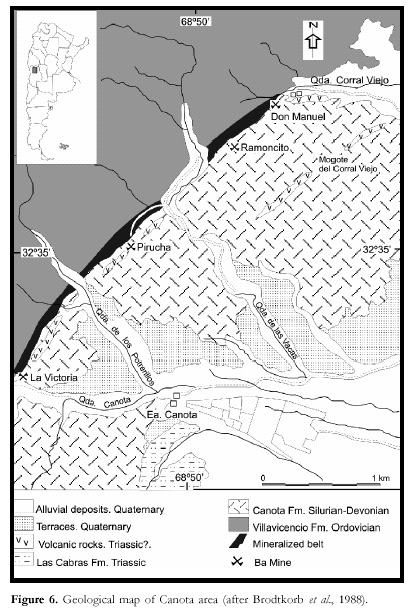
Precordillera
of La Rioja, San Juan an Mendoza provinces
It
is characterized by the great development of deposits from the Lower and Mid
Paleozoic and for the lack or rare occurrence of evident magmatism. The
limestones and dolomites constitute the most important item in the mining of the
application rocks in the Precordillera environment. Their distribution coincides
with the development of the Cambrian and Ordovician. Contents exceptionally high
in calcium carbonate locally occur (Jachal; Villicum and Ullum) and they are
widely exploited.
While
the calcite, in irregular bodies and vein forms, preferably appears in the
ordovician limestones.
Canota
barite Belt
In
an attractive belt of about 10 kilometers of length, with dominant northeast
strike, a group of barite deposits is emplaced in shales of the Villavicencio
Formation that constitutes the barite bearing rock. Moreover, grauwackes,
quartzites and phyllites of Canota Formation (Silurian- Devonian) are found in
the area (Brodtkorb et al., 1988).
The
stratabound deposits, belong to the sedimentary Ordovician sequence where the
barite occurs as nodules, lenticular bodies and stray beds hosted conformable in
the planes of fissility of the black shales from the Caradoc. Disseminations of
barite crystals are also observed in shales.
The
barite nodules shows ellipsoid to subspheroidal forms, with diameters of 15 to
20 cm and 4-8 cm of thickness. The stray beds extend up to 20 m of length and 1
meter of thickness. They show dark gray and black coloration. The density is
about 4. Some mines (Pirucha, Don Manuel, Victoria, among others) were object of
intermittent exploitation from the decade of the 50s until the end of the 80s.
The district offers good reserve perspectives, taking into account the outcrop
distribution along several kilometers in marked a continuity with the
stratigraphy.
Its
genesis is associated with the sedimentary–diagenetic processes in a not very
deep basin with intense organic activity, where the nodular occurrence of barite
took place in supersaturated muds of barium sulphate. The typology is common to
different places of the world and they constitute deposits that make a very
important contribution to the international supply.
Calingasta
and Rodeo Al-Mg Sulphate Deposits
Among
the non metal-bearing resources of San Juan province, it is important to point
out the wide deposits of aluminium and magnesium sulphates that have been
exploited intermittently since 1939. The deposits are located in the western
watershed of the Precordillera, assembled in the sectors km 114 - Calingasta
(northwestern of Sierra del Tontal) and Rodeo (Cuesta del Viento).
The
Alcaparrosa Formation of the Caradoc comprises the sulphate deposits that occur
as impregnations, crack fills and big pockets of very different sizes. The
defined mineral species are: alunogen, pickeringite, halotrichine and epsomite
(Angelelli et al., 1980). The ordovician formation registers an estimated
thickness of 1300 m. It consists of fine, argillo-slimy sediment: shales and
black and gray limolites, in continuous alternation (rhythmites) that show
frequent effusion of volcanic products as pillow lavas. The black shales
register metallic sulphurated elements (Fe, Zn, Cu), besides vanadium and high
contents of carbon. It is frequent the presence of framboidals pyrites
(Schalamuk et al., 1990) which may be associated with small sulphide
contents and in some cases gold traces.
The
sulphate formation is considered as the product of the iron sulphide oxidation
in the shales, the liberation of sulphuric acid and its etched to the components
of the rock itself. The sulphates originated in this way, all them very soluble,
were carried by the waters toward lower levels, crystallizing as different
mineral species in the open spaces of the shales. The formation process,
originated in recent times, becomes effective in greater or lessor degree in the
whole shaly fraction of the Alcaparrosa Fm, and as a product of this, the
sulphate accumulation is very extensive and of big reserves. The areas more
tectonically disturbed are the richest in sulphates. In general the grades vary
between 2 and 6% of aluminium sulphate.
La
Helvecia mine
La
Helvecia mine represents a Pb-Zn-Ba mineralization located in the northwestern
sector of La Rioja province. It is associated with the ordovician sedimentites
of San Juan (limestones), Gualcamayo (shales) and Conglomerado Las Vacas
Formations. It mainly occurs as concordant levels and irregular bodies with
galena, sphalerite and lesser amount of pyrite, chalcopyrite, tetrahedrite and
barite.
The
ore deposit, considered as a stratabound deposit, by Brodtkorb and Brodtkorb
(1999), could belong, according to its mineralogy, to a SEDEX type deposit with
later removilization processes.
The
presence of other mineral prospects of similar characteristics in the Urcushúm
range, enlarges significantly the mineralized area that shows an interesting
prospecting potential.
Mineralizations
related to ophiolitic rocks
Santa
Elena Deposit
It
is a polymetallic deposit located in the western flank of the Precordillera, in
Calingasta area, province of San Juan. The mineralization is interpreted as a
deposit of volcanogenic massive sulphide (VMS) with hydrothermals facies
associated with a basic magmatism, represented by dikes, sills and effusion of
submarine lavas with pillow structure, of basaltic alkaline tholeiitic
composition.
Above
the lavas the sedimentites of the Alcaparrosa Formation are found.
Talc
Deposits
Basic
rocks and serpentine bodies partially altered in talc and other elements, are
located in different metamorphic units, essentially of low grade. The bodies
extend in a belt of ultramafic rocks that begins in San Juan, go throw the
Sierra Cortadera and Uspallata up to the Cordillera Frontal. This belt is
integrated by peridotites, gabbros, serpentines and deposits of talc of 20 to 40
meters long, 1 to 6 meters of thickness and depths of up to 70 meters. Most of
the deposits are located in the Bonilla Formation, Uspallata range, Mendoza
province.
Famatina
System
This
large morphostructural unit registers important sedimentary and
volcanic-sedimentary sequences of the Ordovician, with lavic intercalations.
There is no information that allows to associate definitely the contribution
from the ordovician magmatism with the formation of mineral deposits.
The
occurrence of spilitic breccias with disseminated sulphides is mentioned. At the
same time some polymetallic concentrations are associated with the granitic
plutons of the Famatinian cycle.
Summarizing,
although there is not much information about the metalogenic frame in the
Famatina basin, the great extension and the regional continuity of the
ordovician sequences, justify the development of exploration programs.
Clayds
deposits associated to the Ordovician sedimentites of the Tandilia System
In
the province of Buenos Aires, in the Tandilia System environment, there is an
important package of clays associated with the Ordovician sedimentites of the
Balcarce Formation that have been exploited during decades.
The argillaceous horizons in general are interbedded among quartz rocks levels, mainly outcropping in Balcarce and Claraz areas. In general they are refractory and in lesser proportion plastic clays.
References
Angelelli,
V., 1984. Yacimientos metalíferos de la República Argentina. Comisión de
Investigaciones Científicas de la Provincia de Buenos Aires, 1 y 2, 704
Pag.
Angelelli,
V.; Schalamuk, I. and Fernández, R., 1980. Los yacimientos de minerales no metalíferos y rocas de
aplicación de la región Centro–Cuyo. Secretaría de Estado de Minería,
Anales 19.
Brodtkorb,
M. K.; Schalamuk, I.; Barbieri, M.; Puchelt, H.; Ametrano, S.; Fernández, R.
and Etcheverry, R., 1988. Nodular barite deposits of Canota, Argentina. Proceedings
of the Seventh Quadrennial IAGOD Symposium, 275 – 286.
Brodtkorb,
A. and Brodtkorb, M.K. de, 1999. Distrito La Helvecia (plomo, cinc y bario), La Rioja. En
Zappettini, E. O., ed., Recursos Minerales de la República Argentina. Instituto
de Geología y Recursos Minerales, SEGEMAR. Anales 35: 691-696.
Castillo,
A.; Battaglia, R. and Moya, C., 1996. Depósitos minerales en el Paleozoico
inferior del sector nororiental de Cordillera Oriental, R. Argentina. 7°
Congreso Geológico de Bolivia, 3: 1241-1252.
Coira,
B.; Davidson, J.; Mpodozis, C. and Ramos, V., 1982. Tectonic and magmatic
evolution of the Andes of northern Argentina-Chile. Earth Sci.Rev., 19:
303-332.
Coira,
B. and Koukharsky, M., 1994. Complejos submarinos dómicos-lávicos silíceos de edad ordovícica
en el sector oriental de Puna Jujeña, sus implicancias. 7° Congreso Geológico
Chileno, Actas 2: 1000-1004. Concepción.
Cortés,
J. M.; Franchi, M. R. y Busteros, A.G., 1987. Estratigrafía del Paleozoico
inferior en los Altos del Despensa, Sierra de Aguilar, Argentina. 10º
Congreso Geológico Argentino, Actas 3: 69-72.
González,
O., 1999. Mina Incahuasi, Catamarca. En Zappettini, E. O., ed., Recursos
Minerales de la República Argentina. Instituto de Geología y Recursos
Minerales, SEGEMAR. Anales 35, P. 515-520.
Hongn,
F.; Seggiaro, R.; Guillou, J. A.; Godeas, M. C.; Segal, S. J. and Pezzutti, N.,
1999. Geología y metalogénesis de la Sierra de Calalaste, tramo central,
Catamarca. En Zappettini, E. O., ed., Recursos Minerales de la República
Argentina. Instituto de Geología y Recursos Minerales, SEGEMAR. Anales 35:
523-525.
Lencina,
R. and Peralta, E., 2002. El prospecto Quichagua, un caso testigo de sedex en
Jujuy. Actas del XV Congreso Geológico Argentino. El Calafate.
Lurgo
Mayón, C.S.; Segal, S.J. and Zappettini, E.O., 1999. El yacimiento de sulfuros
masivos La Colorada, Salta. En Zappettini, E.O., (ed), Recursos Minerales de la
República Argentina. Instituto de Geología y Recursos Minerales, SEGEMAR.
Anales 35: 487-492. Buenos Aires.
Méndez,
V. and Méndez, C., 2001. Limeca: ¿prospecto sedex en la puna salteña?. VII
Congreso Argentino de Geología Económica. Actas 1, P. 107-114.
Méndez,
V.; Segal, S.J. and Zappettini, E.O., 2001. Depósitos paleozoicos de metales
base del noroeste de la Argentina: correlación metalogénica y evolución tectónica.
VII Congreso Argentino de Geología Económica. Actas 1, P. 27-34. Salta.
Navarro
García, L. and Rosello, E., 1989. Mineralizaciones auríferas en la Comarca del
Hombre Muerto, Catamarca y Salta. U N T, Serie Correlación Geológica,
3: 51-62.
Pérez,
W.; Lencinas, R. and Peralta, E., 1998. Sedex potencial of the ordovician Basin, NW
Argentina. 10º
Congreso Latinoamericano de Geología y 6º Congreso Nacional de Geología Económica,
V. 2: 381-386.
Buenos Aires.
Rodríguez,
G.A.; de Acevedo, F.I.; Coira, B. and Brodie, C., 2001. Mineralizaciones auríferas
en sedimentitas ordovícicas de la sierra de Rinconada, Jujuy: Implicancias para
la exploración minera. Revista Geológica de Chile. V. 28: 3-22.
Schalamuk,
I. B.; Fernández, R. and Etcheverry, R., 1983. Los yacimientos de minerales no metalíferos y rocas
de aplicación de la región NOA. Dirección Nacional de geología y Minería,
Anales 20.
Schalamuk,
I.B., Brodtkorb, M.K. de and de Barrio, R.E., 1990. Piritas framboidales en
pelitas Eopaleozoicas de San Juan y Mendoza, Argentina. Tercera Reunión
Argentina de Sedimentología, Actas, pg 147-152, San Juan.
Schalamuk,
I. B.; Etcheverry, R. O. y de Barrio, R. E., 1992. Mineralizaciones del
Paleozoico inferior de América del Sur. En: Paleozoico inferior de América
Latina. Universidad de Extremadura, España, Gutiérrez, Marco, Saavedra y
Rabano (Eds.). P. 147-172.
Segal,
S.; Godeas, M.; Pezzutti, N. and Zappettini, E., 1999. Distrito
polimetálico Pumahuasi, Jujuy. En (E.Zappettini ed.) Recursos Minerales de
la República Argentina. Instituto de Geología y Recursos Minerales, SEGEMAR,
anales 35: 493- 497.
Sureda,
R.; Galliski, M.A.; Argañaraz, P. and Daroca, J.,1986. Aspectos metalogénicos
del Noroeste Argentino (provincias de Salta y Jujuy). Revista Capricornio 1 (1):39-96.
Sureda,
R., 1999. Los yacimientos SEDEX de plomo y cinc en la Sierra de Aguilar, Jujuy.
En Zappettini, E. O., ed., Recursos Minerales de la República Argentina.
Instituto de Geología y Recursos Minerales, SEGEMAR. Anales 35, P. 459-485.
Zappettini,
E.O., 1990. Geología y metalogénesis de la Puna Oriental entre los 23° y 23°
45’ de latitud sur, provincias de Jujuy y Salta, República Argentina. Asociación
Argentina de Geólogos Economistas. Publicación especial: 120-127.
Zappettini,
E. O.; Lurgo, C. and Garavilla, R., 1991. Hallazgo de un sulfuro masivo en el
Paleozoico del Noroeste de la República Argentina. El yacimiento polimetálico
La Colorada, Cobres, Provincia de Salta. Revista de la Asociación Argentina
de Geólogos Economistas, V. 8, P. 37-41.
Zappettini,
E. and Segal, S., 1999. Los
depósitos auríferos vetiformes de la Sierra de Rinconada, Jujuy. En
Zappettini,
E. O., ed., Recursos Minerales de la República Argentina. Instituto de
Geología y Recursos Minerales, SEGEMAR, Anales 35: 507-514.
Recibido:
23 de Julio de
2002
Aceptado: 16 de Septiembre de 2002